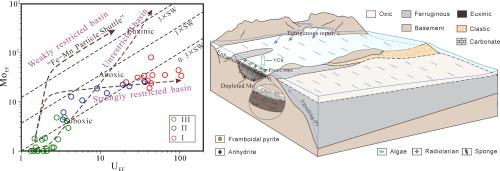当前位置:
X-MOL 学术
›
Gondwana Res.
›
论文详情
Our official English website, www.x-mol.net, welcomes your
feedback! (Note: you will need to create a separate account there.)
Links between hydrographic restriction, redox conditions, and organic matter accumulation in the Early Cambrian intrashelf basin, South China
Gondwana Research ( IF 7.2 ) Pub Date : 2024-06-20 , DOI: 10.1016/j.gr.2024.06.011
Wenyao Xiao , Jian Cao , Zhiwei Liao , Xiaomei Wang , Shuichang Zhang
Gondwana Research ( IF 7.2 ) Pub Date : 2024-06-20 , DOI: 10.1016/j.gr.2024.06.011
Wenyao Xiao , Jian Cao , Zhiwei Liao , Xiaomei Wang , Shuichang Zhang

|
There was a strong relationship between paleo-oceanic conditions and organic matter accumulation during the critical period of the Early Cambrian. The Yangtze Platform in South China provides an opportunity to study this relationship, but the basin architecture and paleo-hydrographic dynamics remain poorly understood, which hinders one’s understanding of the evolution in oceanic redox state and its relationship to organic matter accumulation. To fill the knowledge gap, a newly obtained data set from the Lower Cambrian Niutitang Formation shales (Late Cambrian Stage 2-Stage 3) of the intrashelf basin is used. Results show that the molybdenum–uranium covariation, along with the abnormally low Mo contents and Mo/TOC ratios in the anoxic (ferruginous and euxinic) Niutitang shales of the intrashelf basin, indicate a hydrographic circulation that is moderately to strongly restricted. The hydrographic evolution at different stages, influencing redox conditions to a certain extent, in conjunction with variations in primary productivity, controls the enrichment of organic matter. In particular, the relatively low sea level during Interval I (Late Stage 2) resulted in weak connectivity between the intrashelf basin and open ocean; this, coupled with high primary productivity and enhanced chemical weathering, formed stable stratified water (euxinic bottom-water) conditions that were favorable for organic matter enrichment. In contrast, Interval II (Early–Middle Stage 3) and Interval III (Late Stage 3) involved less organic matter enrichment due to weakened restricted hydrographic circulation (Interval II) and oxic bottom-water conditions (Interval III). This study highlights how hydrodynamic processes affected the marine environment during the Early Cambrian and reveals that sluggish oceanic circulation combined with high primary productivity led to anomalous enrichment of organic matter. This may be a common feature of basins with restricted hydrographic circulation in deep time.
中文翻译:

华南地区早寒武世大陆架内盆地水文限制、氧化还原条件和有机物积累之间的联系
在早寒武纪的关键时期,古海洋条件与有机质积累之间存在很强的关系。华南地区的长江地台为研究这种关系提供了机会,但对流域结构和古水文动力学仍然知之甚少,这阻碍了人们对海洋氧化还原状态演变及其与有机物积累关系的理解。为了填补知识空白,使用了来自大陆架内盆地的下寒武统 Niutitang 组页岩(晚寒武世 2 期至 3 期)新获得的数据集。结果表明,钼-铀协变,以及大陆架内盆地缺氧(铁质和真轴质)牛蒂唐页岩中异常低的 Mo 含量和 Mo/TOC 比率,表明水文环流受到中度至高度限制。不同阶段的水文演化在一定程度上影响了氧化还原条件,再加上初级生产力的变化,控制了有机物的富集。特别是,在间隔 I(第 2 阶段晚期)期间相对较低的海平面导致大陆架内盆地和开阔海洋之间的连通性较弱;这与高初级生产力和增强的化学风化作用相结合,形成了有利于有机物富集的稳定分层水(Euxinic Bottom-Water)条件。相比之下,间隔 II(早期-中期 3)和间隔 III(晚期 3)由于限制性水文环流减弱(间隔 II)和含氧底水条件(间隔 III)而涉及较少的有机物富集。 本研究强调了早期寒武纪水动力过程如何影响海洋环境,并揭示了缓慢的海洋环流与高初级生产力相结合,导致了有机物的异常富集。这可能是深时水文环流受限的流域的共同特征。
更新日期:2024-06-20
中文翻译:

华南地区早寒武世大陆架内盆地水文限制、氧化还原条件和有机物积累之间的联系
在早寒武纪的关键时期,古海洋条件与有机质积累之间存在很强的关系。华南地区的长江地台为研究这种关系提供了机会,但对流域结构和古水文动力学仍然知之甚少,这阻碍了人们对海洋氧化还原状态演变及其与有机物积累关系的理解。为了填补知识空白,使用了来自大陆架内盆地的下寒武统 Niutitang 组页岩(晚寒武世 2 期至 3 期)新获得的数据集。结果表明,钼-铀协变,以及大陆架内盆地缺氧(铁质和真轴质)牛蒂唐页岩中异常低的 Mo 含量和 Mo/TOC 比率,表明水文环流受到中度至高度限制。不同阶段的水文演化在一定程度上影响了氧化还原条件,再加上初级生产力的变化,控制了有机物的富集。特别是,在间隔 I(第 2 阶段晚期)期间相对较低的海平面导致大陆架内盆地和开阔海洋之间的连通性较弱;这与高初级生产力和增强的化学风化作用相结合,形成了有利于有机物富集的稳定分层水(Euxinic Bottom-Water)条件。相比之下,间隔 II(早期-中期 3)和间隔 III(晚期 3)由于限制性水文环流减弱(间隔 II)和含氧底水条件(间隔 III)而涉及较少的有机物富集。 本研究强调了早期寒武纪水动力过程如何影响海洋环境,并揭示了缓慢的海洋环流与高初级生产力相结合,导致了有机物的异常富集。这可能是深时水文环流受限的流域的共同特征。

































 京公网安备 11010802027423号
京公网安备 11010802027423号